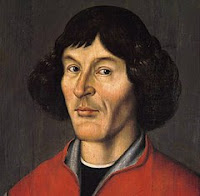 |
| Nicolaus Copernicus |
Physics has been, for the last seven centuries, the queen of sciences: its object is the study of the lowest-level of reality; its most akin to mathematics; it has seen happen the highest number of new, spectacular and revolutionary theories and discoveries. Let's see a few of them:
- 13th century: Roger Bacon studies reflection, refraction,
spherical aberration and the use of lenses to correct vision defects. He
also suggests the possibility of building telescopes, microscopes, and
flying vehicles.
- 14th century: Jean Buridan, Nicolás Oresme, Albert of
Saxony and the calculators
of Merton College revolutionize Mechanics, separating it for the first
time from the work of the Greek philosophers, and introducing new concepts
such as impetus.
- 16th century: Copernicus proposes replacing Ptolemy's geocentric
system by a much simpler heliocentric system. Kepler modifies the theory
of Copernicus and discovers the three empirical laws that bear his name.
- 17th century: Galileo perfects the telescope and makes with it
astronomical discoveries. He also recapitulates and organizes the
mechanical discoveries of the 14th century. Newton revolutionizes physics
with the theory of universal gravitation, which unifies terrestrial and
celestial mechanics, and makes great advances in optics. Other important
physicists of that century are Pascal, Huygens, Boyle, Mariotte, and many
more.
- 18th century: Although it's possible to detect a certain slowdown
in scientific research, we can mention the Bernoulli brothers, and near the
19th century, Galvani, Volta and Laplace.
- In the 19th century, discoveries in theoretical and experimental
physics and the number of professional physicists increased dramatically. Let's
mention just a few of the most important: Dalton, Faraday, Ampère, Gauss,
Maxwell, Carnot, Lord Kelvin and Boltzmann.
 |
| Werner Heisenberg |
At the end of the 19th
century, some physicists spread the idea that we already knew everything, that
there was nothing left to discover. Just two phenomena had no explanation yet:
black body radiation, and the constancy of the speed of light in a vacuum, proved
by Michelson's experiment. As soon as we knew that, theoretical physics would
be closed, possibly forever.
Since the year 1895,
events hastened. A series of unexpected discoveries revolutionized physics,
opening new fields of research and leading to spectacular advances and the
formulation of new and revolutionary theories. Let's cite a few of the most
important:
- 1895-98: Discovery of X-rays by Röntgen, and of natural
radioactivity by Becquerel and the Curies.
- 1900: Planck's quantum theory, which explained black body
radiation.
- 1905: Explanation of the photoelectric effect by Einstein. Special
Theory of Relativity, which explained Michelson's experiment.
- 1911-13: Rutherford and Bohr atomic models.
- 1915: Einstein's General Theory of Relativity, experimentally
proven in 1919.
- 1924: Corpuscular-wave theory of matter, by De Broglie.
- 1926: Quantum mechanics by
Bohr, Heisenberg and Schrödinger.
- 1931: Theory of the Big Bang, by Lemaître.
- 1948: Starting from the Big Bang theory, Alpher, Gamow and Herman
predict the cosmic background radiation and the average composition of the
cosmos.
- 1960s: Glashow, Salam, and Weinberg formulate the electroweak
theory, which unifies electromagnetism with the weak nuclear interaction.
Murray Gell-Man formulates the theory of quarks. Prediction of the Higgs
boson.
 |
| String Theory |
Since then, 50 years later,
there have been no comparable advances in theoretical physics. Of course, many
theories have been formulated, such as Grand
Unification, strings and
superstrings, various multiverse
theories, cosmic inflation,
and many more, but none of them have received the slightest confirmation. Does
that mean that physics is in crisis?
Francisco José Soler Gil
thinks so. In his book The Enigma of Natural Order, which I talked
about in a
previous post, he points out that, although the number of living doctors in
physics exceeds the number of all those who had lived previously, and though the
number of published articles has grown exponentially, the results have been
disappointing.
But Soler Gil is not alone in pointing out this situation. As early as 1996, the science journalist John Horgan did the same in his book The End of Science, where he coined the term ironic science and applied it to scientific theories that cannot be confirmed or falsified, such as those of multiverses. In 2006, the physicist Lee Smolin (author, by the way, of one of the multiverse theories) elaborated on the same idea in his book The trouble with physics. And the German physicist Sabine Hossenfelder, about whom I spoke in a previous post, has provided strong arguments in her essay Lost in Math, published in 2018, where she says that current physics is governed by hidden principles, such as naturalness, simplicity and elegance... which flagrantly contradict the scientific goal of objectivity. Hidden principles that, as Soler rightly points out, are philosophical in nature. Hossenfelder asserts that these principles in the field of aesthetics are used unthinkingly in the construction of the theoretical models of current physics, and suggests that it would be necessary to revise them to get out of the deadlock in which the discipline finds itself. This last quote is from the book by Soler Gil, who ends by pointing out another possible philosophical obstacle that may be contributing to the current paralysis of fundamental physics: the growing loss of faith in scientific realism.
Thematic Thread on Philosophy and Logic: Previous Next
Manuel Alfonseca
No comments:
Post a Comment